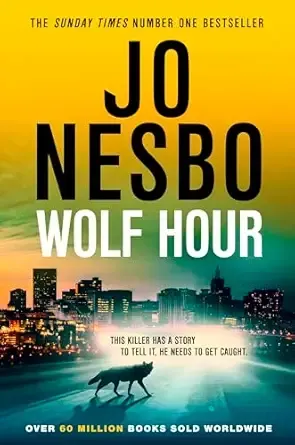The Line Between Hunter and Hunted

A killer leaves messages in flesh. A detective searches for meaning in madness. This is not just a thriller. No! Iit’s a howl from the edge of justice.
Image: Supplied
The universe has a way of speaking to us that’s both mysterious and relentless. For me, it talks through words and titles that surface repeatedly, almost like coded messages waiting to be uncovered.
In the week leading up to reading Jo Nesbo’s Wolf Hour, the word “wolf” appeared all around me, threading through my life with unmistakable intention. From signs I passed to a powerful workshop called The Code of the She Wolf, I felt a growing call to lean into the wisdom and mystery wrapped in that symbol. My connection runs deep, made even more personal by memories of my beloved hybrid wolf pairs, Nala and Zazu, dogs who embodied wildness, loyalty, and protection in my life.
Justice in the Fog
With that background, the novel felt like a conversation between the story and my soul. Set in 2016 Minneapolis, it follows Detective Bob Oz, a complex lone wolf figure haunted by the tragic death of his daughter and struggles with addiction. Recognisable by his bold yellow cashmere coat, he navigates not only the city’s dark streets but also his internal demons.
The story opens with a chilling murder, the sniper shooting of a small-time crook known in the drug trade. Tomas Gomez is the obvious suspect, a gangster whose name echoes through the city’s underworld. But Oz’s intuition tells him the case is far from simple. This is no straightforward criminal tale. It’s a twisted game where the real killer wants to be seen. His murders are messages written in blood.
Chaos, Bureaucracy, and the Breakdown of Order
As the investigation unfolds, tensions mount. The killings spread from gangsters to a businessman, drawing the attention of city officials and deepening public unease. When investigators begin to suspect that the mayor may be the killer’s next target, political pressure surges. Oz finds himself caught in the crossfire of bullets, bureaucracy, and manipulation. His unorthodox methods and struggle with addiction lead to suspension. Removed from the case, he is sidelined, yet his intensity and insight remain too compelling to ignore. His colleague, Detective Kay Myers, secretly calls him in for guidance.
The investigation soon becomes tangled in competing agendas and uncertainty. Under mounting pressure to deliver results, senior officers move hastily, driven more by politics than truth. Though officially excluded, he senses that the real motive lies deeper than anyone wants to admit. Beneath the surface, shifting loyalties and quiet acts of defiance reveal a system at war with itself, a reminder that even within the pack, survival depends on instinct and courage.
Masks, Madness, and the Taxidermist’s Truth
The breakthrough comes through an unlikely friendship with a taxidermist, Mike Lund, who becomes both a source and a suspect. His family had been tragically caught in gang crossfire, driving him into a vengeful rampage disguised behind grotesque masks fashioned from the skin of Gomez and others. His actions blur terrifying lines between hunter and hunted, victim and villain.
The climax is heart-pounding and tragic. In a tense confrontation, Mike reveals the depths of his pain and madness before taking his own life, leaving a haunting emptiness. The detective, battling his own ghosts, stands as both judge and mirror, questioning what separates man from monster.
Wild Grace and the Spirit of the Wolf
This narrative is a potent reflection on loneliness, justice, and survival, themes that resonate deeply with the lone wolf spirit I admire. Oz’s journey, laden with flawed humanity and fierce determination, reminded me of the lessons from The Code of the She Wolf — strength balanced with compassion, fierce independence woven with the need for connection.
Nala and Zazu’s spirits were with me through every twist and dark revelation, symbols of loyalty and wild grace amid life’s chaos. My advocacy for animal welfare feels aligned with these themes, as wolves teach resilience, community, and the fight for survival against odds.
More Than a Thriller: A Journey Worth Taking
Beyond the plot and investigation, what makes Wolf Hour unforgettable is how it examines the subtle interplay between obsession, justice, and human connection. Nesbo shows that even in the darkest circumstances, the pursuit of truth reveals unexpected alliances and quiet acts of courage. For me, the story resonated on a personal level, reminding me that understanding, empathy, and vigilance are as essential as instinct and skill — whether in facing external challenges or confronting the inner struggles that shape who we are.
* Wolf Hour is available at Exclusive Books.
Related Topics: